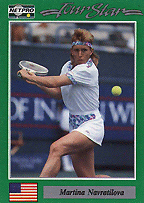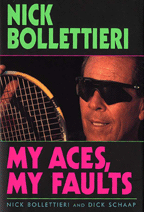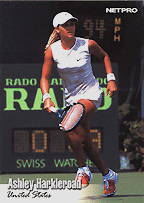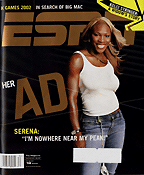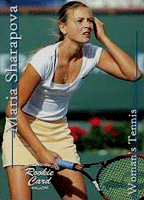![]()
Blonde, leggy, and beautiful. If those are the only adjectives you use
to describe Maria Sharapova, then you’re selling the tennis world’s
newest star short. While she may compare favorably to Anna Kournikova
on the modeling runway, Maria is most dazzling when she steps on the tennis
court. Her serve is overpowering, her ground strokes are penetrating,
and her will to win is punishing. Maria officially arrived with her 2004
Wimbledon title—and she’s not likely to leave anytime soon.
This is her story…
GROWING UP
Maria was born April
19, 1987 in Nyagan, a town in western Siberia, where her parents, Yuri
and Yelena, had fled from Belarus a year earlier to avoid radiation from
Chernobyl. Still too close to the disaster site, her family left their
home as refugees again when she was two-years-old. The Sharapovs (Maria
uses the feminine Sharapova) settled for a while in the Black Sea town
of Sochi, known then as a resort village and home of Russian tennis light,
Yevgeny Kafelnikov. Yuri had been an engineer in Nyagan. But as the family
bounced from on home to the next, he did anything he could just to keep
them together.
An only child, Maria was encouraged by her parents to try everything,
from dancing and music to athletics. She discovered tennis after her fourth
birthday, when a family friend—Kafelnikov’s father—gave
her one of his son’s old Dunlop tennis racquets. The die was cast.
Maria hardly ever let that cut-down, cracked, destrung racquet out of
her hand from the moment she picked it up. Every day she hit balls against
the side of the house.
By the time Maria
was six, local tennis coaches encouraged Yuri to take her to Moscow to
be considered for the Russian Tennis Federation. There, she wowed RTF
head coach Yuri Udkin, who felt she was the best tennis player he had
ever seen.
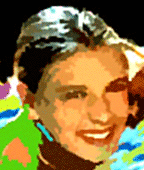
But things were not so simple in Russia, where the old order was changing. The Russian government had increased its tennis development program after the sport had gained Olympic status in the early 1980s. But even though ample funding was available, Maria’s parents followed the advice of Martina Navratilova, who believed that the U.S. would be the best place for the youngster to receive her training. The Sharapovs had met Navratilova during an exhibition in Moscow. The tennis legend was happy to offer her assistance.
Maria emigrated to Bradenton, Florida with her father, but Yelena was forced to stay behind when she could not get a visa. Once there, father and daughter tried to get her accepted at the world-famous Bollettieri Sports Academy. They also learned to speak English, Maria picking up much of the language in a month's time.
Maria and her dad made the trip from Russia to Florida with a scant $1,000 in their bankroll, scraped together from their life savings and gifts from grandparents and friends. Yuri also added to the small nest egg by laboring in the mines of Siberia. Unsure even where Bradenton was, they eventually arrived in the Sunshine State amid catcalls from parents complaining Maria was an outsider, too young and not talented enough. Bolletieri, however, sensed something special in her. Maria began her education at his “dream factory”—the same tennis school that had produced the likes of Andre Agassi, Monica Seles, Mary Pierce and Jim Courier.
At first, Yuri had to pay for seven-year-old Maria to play at Bollettieri’s. To foot the bill, he worked at all manner of jobs, including maintaining the greens at a local golf course. The two grew even closer during this period. Maria tried to focus on tennis, while Yuri concentrated on their survival. She began entering 12-and-under tournaments, and acquitted herself quite well, ascending to #15 in her age group.
Around this time,
Bollettieri offered a glimpse of Maria to execs at International Management
Group, the global sports representation and marketing agency that owned
his academy. They were blown away, and immediately put her on full scholarship.
Life became more comfortable for Maria and Yuri, but by no means easy.
Jealous Russian rivals bad-mouthed her regularly. Her training regimen,
meanwhile, intensified greatly. Video cameras recorded her every move
during practice, both to break down her form and chronicle her behavior.
Maria sat down with coaches to examine everything, from facial expressions
to body language. The goal was to maximize her performance by channeling
her emotions into positive outlets.
The hard work paid
off. In 1997, Maria won the Eddie Herr International Junior Championships,
upsetting Bernice Burlet in the first round in the 14-under division.
By age 11, Maria was splitting her time between IMG, her home just outside Tampa, and the Los Angeles courts of Robert Lansdorp, whom she took on as her primary coach. A year later, Yuri began to get impatient. At one point, Bollettieri had to explain to him that rules prevented the 12-year-old from competing as a professional.
ON THE RISE
In April of 2000, just a week short of her 13th birthday, Maria stole center stage when she battled back twice to win a fantastic match (7-6 (8-6), 6-4) against Myriam Casanova, and capture the title in Girls 16s of the Eddie Herr International Junior Tennis Championships.
Comparisons began to all-time greats like Seles. Though their games were different, Maria displayed the same determination and poise under pressure. For her efforts, she earned her sport’s first “Rising Star Award.”
In 2001, at the age of 14, Maria turned pro and made her debut at an ITF event in nearby Sarasota. She continued to work at the academy all year in preparation for 2002, when she would play a full schedule. Still unranked, Maria opened the following year on a high note, by advancing to the finals of the Australian Open juniors. Just 14, she was the youngest finalist in the tournament’s history. Demonstrating her penchant for grass courts, she did the same in the Wimbledon juniors in July. Afterwards, she told the press that she had the Williams sisters in her sights.
Months later, Maria was invited to play as a wild card in the Pacific Life Classic. In just her third pro event, she tore through Brie Rippner (5-7, 6-2, 6-2) in the opening round. Though she fell to Seles in her next match, she had done enough to garner a spot in the WTA Rankings at No. 532. Maria went on to reach the final at five consecutive ITF Circuit tournaments, winning three of them. She also played in Tokyo at the Japan Open, bowing out in the first round to Emmanuelle Gagliardi in three sets. She ended the year ranked 186 in the world.
Maria continued her climb in 2003. She started the year in impressive fashion, rolling through her preliminary matches to qualify for her first Grand Slam, the Australian Open. Her first opponent, 10th-seeded Renata Voracova, presented few problems, as Maria dispatched her 6-3, 7-5. She also had no trouble with Maria Goloviznina (6-3, 6-2) in the next round. In the her last match of the qualifier, Maria handled Alena Vaskova with ease, 6-1, 6-2 .
The opening round of the Australian Open wasn’t quite as kind to her. Maria lost to Klara Koukalova in two sets. In doubles, meanwhile, she teamed up with Marion Bartoli . The pair beat Eleni Daniilidou and Caroline Vis, before being eliminated by Ruano Pascual and Paola Suarez.
Maria cracked the top 100 in the world rankings five months later at the DFS Classic in Birmingham, England. On her way to the semi-finals, she beat Evgenia Koulikovskaya, Nathalie Dechy, Marie Gaianet Mikaelian and Elena Dementieva. The real surprise came when she fell to Japan’s Shinobu Asogoe just a step away from the final.
As Maria’s game
improved, her detractors also grew louder. The biggest knock against her
was the noise level at which she played. Even if fans weren’t watching
one of Maria’s matches, they could usually hear her grunting from
the baseline. Her boisterous style threw off some opponents, who questioned
whether she really needed to range around the court at such a high decibel
level.
Maria silenced her cirtics at Wimbledon, which she entered as a wild card. Facing Ashley Harkleroad, another notably loud player, Maria won 6-2, 6-1. Next she disposed of Elena Bovina, setting up a showdown with 11th-seeded Jelena Dokic. With her shins bothering her, Maria—also playing mixed doubles with Alex Bogdanovic—had to excuse herself from that part of the draw. But she was ready for Dokic, earning a 6-4, 6-4 victory. Maria’s amazing run ended in the Round of 16 with a three-set defeat to Svetlana Kuznetsova. Still, she served notice that she was for real, as her ranking rose to 91.
Weeks later, in a tune-up for the U.S. Open, Maria put a scare into Kim Clijsters, extending her to three sets in a match in Los Angeles. But the hard courts at Flushing Meadows proved too much for her. After a tough victory over Virginia Ruano Pascual, she exited in the second round.
Heading into the fall, Maria remained poised for a breakthrough. She delivered in October, becoming the year’s youngest winner (16 years, five months, 16 days) on the WTA Tour by taking the singles and doubles (with Tamarine Tanasugarn) titles at the Japan Open. She and Tanasugarn kept on rolling in Luxembourg with another victory. Maria also reached the semis in the singles, dropping another compelling match to Clijsters. In her final event of season in Quebec City, Maria walked away with a second singles title, after Milagros Sequera was forced to retire in final with a fractured left ankle. Maria’s WTA ranking jumped to 31.
MAKING HER MARK
Back in Melbourne to begin 2004, Maria ran into problems at the Australia Open. She pulled out of the doubles with a leg injury, hoping to gut it out in the singles draw. But Anastasia Myskina sent her packing in the third round.
In February, Maria
faltered again, at the Pan Pacific in Tokyo. After a first-round victory,
she fell to Daniella Hantuchova. The news was better two weeks later,
when Maria moved into the Top 25. Playing in Memphis, she reached the
semis in singles, before getting ousted by eventual champion Vera Zvonareva.
The loss was bittersweet, because Zvonareva was a friend, and the two
were also paired in doubles. They came up short, however, in the final.
The next few months brought more ups and downs for Maria. She faced Serena Williams for the first time in her career, but had trouble figuring out her game and lost the match. In April, she surged to No. 19 in the world (making her one of six Russians that week in Top 20). Weeks later in Berlin, she advanced to the third round, and then lost to Jennifer Capriati. In Rome, Maria upset Elena Dementieva, but was defeated two rounds later by Farina Elia.
Maria went into the French Open unsure what to expect. Seeded 18 at Roland Garros, she whipped Zvonareva en route to her first quarter-final appearance in a Grand Slam event. But her bubble burst is in a straight-sets defeat to Paola Surez. Some critics wondered whether Maria was destined to be the next Anna Kournikova. She was eager to set herself apart.
In June, Maria made a statement on the grass at Birmingham by winning the singles and doubles titles. With her world ranking at 15, Maria was full of confidence heading into Wimbledon.
She opened the tournament by dispatching Yulia Beygelzimer, Anne Keothavong, Daniela Hantuchova, Amy Frazier in straight sets. The 13th-ranked Frazier gave Maria her first real test, surrendering few breaks in their 6-4, 7-5 struggle.
Japan’s Ai Sugiyama took a set from Maria for the first time in their quarter-final tilt, opening the match with a 7-5 victory. But Maria turned the tables in the second set, winning 7-5, and then closed out Sugiyama 6-1 to advance to the semis.
The turning point
of Wimbledon for Maria came against Lindsay Davenport. The hard-hitting
American overwhelmed her young opponent 6-2 in the opening set, and had
control of the match in the second. That's when Maria did something few
teenagers can do in this situation—she started banging winners and
taking the match to the veteran. Minutes later Maria forced a tiebreaker,
which she won 7-4. With Davenport nursing a sore knee, Maria closed her
out 6-1 to reach the finals.
Maria faced Serena Williams in the final. The odds against a victory were astronomical, as Williams had six Grand Slam titles to here credit, along with a 20-match winning streak on grass. Maria’s best hope was to go toe-to-toe with the American slugger. She had beaten Sugiyama and Davenport—both powerful hitters—by bringing her A Game when they were less than their best. Would the same scenario play out a third time?
In one of the most stunning upsets in Wimbledon history, Maria triumphed 6-1, 6-4. Neither player served well, but Maria took chances on her second serve—struck at nearly 100 mph—and kept Williams on the defensive. Serena, who was clearly out of rhythm, seemed content to let Maria flame out. But it never happened. Maria became the third-youngest Wimbledon champion of the Open era, and the first Russian ever to win the All England title.
After her Wimbledon
title, Maria—who vaulted into the Top 10, and surpassed $1 million
in earnings for 2004—began the adjustment to life as a superstar.
Citing a need for rest and recuperation, she cancelled her plans to play
the JPMorgan Chase Open and Newport Beach Breakers, but kept her word
and appeared at a children’s clinic with the New Haven Parks &
Recreation summer camps. She also posted a couple of questionable losses,
and is feeling the wrath of her compatriots, who have attacked her for
being a Russian in American clothing.
Meanwhile,
no one was handing Maria the U.S. Open title. The stars had aligned perfectly
at Wimbledon, and she had ambushed a quartet of fine players. But now
the entire tour was gunning for her. The book on Maria was that you could
beat her by varying pace and strategy, and Mary Pierce proved this when
she ran off the final five games of their match at Flushing Meadow to
end Maria’s chances at a second straight Grand Slam title. Maria’s
second serve was not clicking, and she refused to adjust. Fourteen double-faults
later, she was watching Pierce wave to the cheering crowd at Arthur Ashe
Stadium.
No
one in Maria's camp was panicking. With the pressure of the Open out of
the way, she got back to the business of adding complexity to her game.
In
the season-ending WTA Championship, Maria beat Anastasia Myskina in the
semis to set up a rematch with Serena. She dropped the first set, and
then bounced back to even the match. After watching Williams—who
strained an abdominal muscle during their battle—win the first four
games of
the third set, Maria sucked it up and reeled off the next six to take
the title. It marked only the second time all year a player had beaten
Serena after losing the opening set.
The victory vaulted Maria into the Top 5 for the first time, giving her a final no. 4 ranking for the year. She finished with $2.5 million in prize money to top the women's tour.
If all goes as planned,
Maria will be a lot harder to unnerve at 18 than she
was at 17. In the meantime, Maria has proven she's more than just another
pretty face; she has served noticed that she will continue to be the woman
to
beat at the majors.
In tennis, they say that winners make it happen, while losers hope it happens. Maria subscribes to this philosophy. Her aim is to quickly gain control of a point, pound the ball into the corner, and then come inside the baseline and attack her opponent. The better the opponent, the riskier this is—and the quicker Maria must be.
At the top level of women’s tennis, Maria’s opponents are still dangerous when cornered. As she charges toward the net, she must be prepared to execute a cross-court volley, down-the-line lunge, or deal with a perfectly placed floater. Above all, however, she must be mentally prepared to put away the next shot. Her coach, Robert Lansdorp, calls this “attacking blindly” and Maria is already one of the best ever at this approach.
Maria’s serve triggers much of her game. Her first serve is one of the better ones in the game, but still lacks consistency. She is unafraid, however, to launch an equally hard second serve, so the receiver can never dictate a point. If Maria’s second serve is off, then she’s in trouble.
As Maria gains more
experience and develops more strength and consistency, she may decide
to alter her approach. But for now, her strategy suits her strokes, as
witnessed by her humiliation of Serena Williams at Wimbledon.




